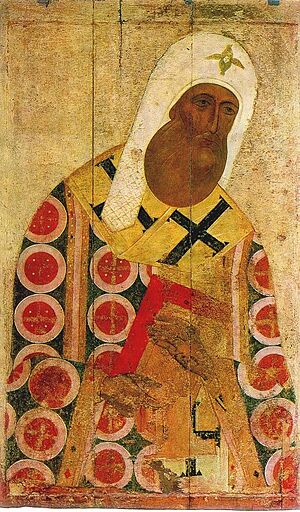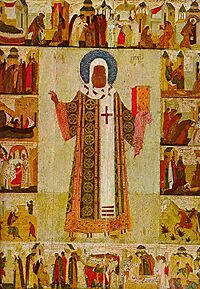Peter of Moscow facts for kids
Quick facts for kids |
|
|---|---|
| Metropolitan of Kiev and all Rus' | |
| Church | Ecumenical Patriarchate of Constantinople |
| See | Moscow |
| Enthroned | 1308 |
| Reign ended | 1326 |
| Predecessor | Maximos, Metropolitan of all Rus' |
| Successor | Theognostus of Kiev |
| Saint Peter of Moscow |
|
|---|---|

15th-century Russian Icon of Metropolitan Saint Peter of Moscow
|
|
| Confessor and Wonderworker | |
| Born | c. 1260 Volhynia, Kingdom of Galicia–Volhynia |
| Died | 21 December 1326 (aged 66) Moscow, Grand Duchy of Moscow |
| Venerated in | Eastern Orthodoxy |
| Canonized | 1339 by Metropolitan Alexis of Kiev |
| Major shrine | Cathedral of the Dormition, Moscow, Russia |
| Feast |
|
| Patronage | Moscow |
Peter of Moscow (born around 1260, died December 20, 1326) was an important Russian church leader. He is famous for moving the main church office, called the metropolitan see, from Vladimir to Moscow in 1325. Later, he became known as a patron saint of Moscow. Even after the move, his official title remained "Metropolitan of Kiev and all Rus'" for many years. This title stayed the same until Jonah of Moscow was chosen as the new leader in 1448.
Contents
Early Life and Monastic Journey
Peter was born in a region called Volhynia, which was part of the Kingdom of Galicia–Volhynia. His parents were Theodore and Eupraxia. When Peter was about twelve years old, he joined a monastery. There, he learned how to paint religious pictures, known as icons.
The head of the monastery, called an igumen, later made Peter a hieromonk. This means he was a monk who was also a priest. After many years of living a strict, religious life in the monastery, Peter decided to seek a quieter place. With the igumen's blessing, he left to find a solitary spot.
Building a New Monastery
Peter built a small cell, a simple room, by the Rata River. He began to live a very quiet and prayerful life there. Over time, other people joined him, and a monastery was formed. It was named Novodvorsk.
Peter also painted a special icon of the Most Holy Theotokos, which means "Mother of God." This icon became known as "Of St Peter" because he painted it while he was the igumen of the Ratsk monastery near Volhynia. Later, when Maximus, the Metropolitan of Kiev and all Rus', visited the Ratne monastery, Peter gave him this icon as a gift.
Becoming Metropolitan of Rus'
In 1308, King Boleslaw-Yuri II of Galicia chose Peter to become the new Metropolitan of Kiev and all Rus'. The Patriarch of Constantinople, the head of the Eastern Orthodox Church, then officially appointed him. This was a very important position, like being the head of the church for a large region.
However, Mikhail Yaroslavich, a powerful prince from Vladimir and Tver, wanted his own candidate for this role. This caused a long-lasting disagreement between Mikhail and Peter. The conflict was so serious that Peter had to ask for protection from the Prince of Moscow in 1325.
Journey to Constantinople
To become the Metropolitan, Peter traveled to Constantinople. There, Patriarch Athanasius officially made him the Metropolitan of Rus'. He also gave Peter special church clothes, a staff, and an icon. Peter returned to Rus' in 1308, arriving in Kiev after about a year. He then continued his journey to Vladimir.
During this time, the region of Rus' was in a lot of trouble. The Tatar, or Mongol, rulers had great power, and the land was often in chaos. Because of this, Peter often had to change where he lived.
Moving the Church Headquarters to Moscow
Peter first moved his main church duties from Kiev, which was not as populated anymore, to Vladimir. Then, in 1325, something very important happened. Grand Prince Ivan Kalita of Moscow asked Metropolitan Peter to move the metropolitan cathedra, or the main church chair, from Vladimir to Moscow.
Peter agreed to this request. This move greatly helped Moscow become more powerful politically. It also made Moscow the spiritual capital of the many smaller parts of Rus'. After Peter moved to Moscow, Ivan Kalita built the Cathedral of the Dormition and several other stone churches inside the Moscow Kremlin. It is also believed that Peter helped start the Vysokopetrovsky Monastery in Moscow. He also wrote some sermons and letters.
Peter passed away on December 21, 1326. After he was officially recognized as a saint by Metropolitan Alexis, people across Moscovy began to honor him. Many churches in Moscow and other Russian cities were named after Metropolitan Peter. His feast day, a special day to celebrate him, is observed on August 24. This date marks the day his relics, or holy remains, were moved to the Dormition Cathedral in Moscow. Another feast day is on October 5, which he shares with Metropolitans Jonah and Alexis.
Images for kids



